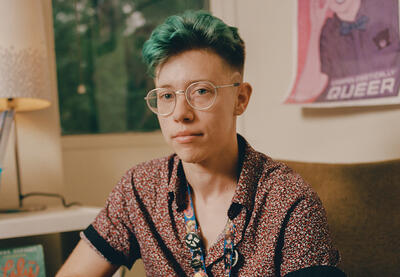Letters, notes, drawings—we educators cherish the treasures our students and communities hand us. The thank-you’s through the year, and especially at the end, wrap around our hearts and sustain us to the next year. I’ve always kept those words and pictures close to me. My notes are often different from those of many other educators. Yes, I receive the thank-you’s and the drawings, but now my notes include the words proud and nonbinary. And I get a lot of rainbows along with messages like “thank you for being you” and “you’re my favorite nonbinary teacher!”
I have the privilege to be visibly out to my students. Not only do I have blue hair, use they/them pronouns and go by Mx. Tooley, but I also had the access to get affirming top surgery this past year and to start testosterone. My journey, even though I didn’t talk about it with my students, was visible to everyone on campus as my voice and body changed. I became more fully myself this year as I stepped into the body that my brain had always envisioned.
Queer people existing as authentically themselves is powerful. It’s no wonder multiple groups who have always used power to disenfranchise and maintain inequitable structures are focused on removing our existence and LGBTQ+ history from the classroom. From blocking access to gender-affirming care and denying trans kids’ safety in schools to banning queer books, the attacks against queer people simply living openly—and especially those who teach in K-12 classrooms—is widespread in the United States. Hidden under the guise of “protecting children” and the rhetoric that teachers should “only teach curriculum” is blatant and violent homophobia and transphobia. Anti-LGBTQ+ words, beliefs and policies are being used to systematically erase queer educators as well as our queer students.
Our visibility is power. When we see ourselves represented, we get to know ourselves and know we exist—we are not alone. When we hear and see other people’s stories, we are invited in to share space and to learn. And in learning about one another’s stories, we develop empathy and understanding. We become a community who advocates for one another. This is what happens in my classroom. This year, I watched as my learners became fierce advocates for human rights and developed the first Rainbow Club at our school. I watched as they asked thoughtful questions, learned about and respected each other’s identities and came to new understandings of the world around them.
When we say teaching must be ethical and inclusive, we are not just referring to educators advocating for our students and our communities and teaching social justice. These things are vital, but it goes deeper than that. Teaching must be inclusive because each student comes into our room holding their identities, wondering if they will be seen in the space. Teaching is an ethical responsibility because our students are coming into the classroom with new thoughts, ideas, traumas and realizations as the world opens up to them, and they are making connections within themselves, to each other and to the broader community—and it’s an educator’s responsibility to create an inclusive space where students can express those parts of themselves. My visibility opens that space for my students to feel visible, to know they are accepted in all their identities and to see and empathize with one another.
It is in community that action and change happen. In our brave space in the classroom, we can communicate boldly and thoughtfully to challenge preconceived notions of one another and think deeply about the events that are unfolding before us and the events that unfolded in the past. With those connections, we can then look to the future together, build hope together and create community together. And that’s why I teach. I teach because stories and visibility are power. I teach because advocacy and words are power. With that power, we and our young people can lift up ourselves and our communities and work to all thrive together.
